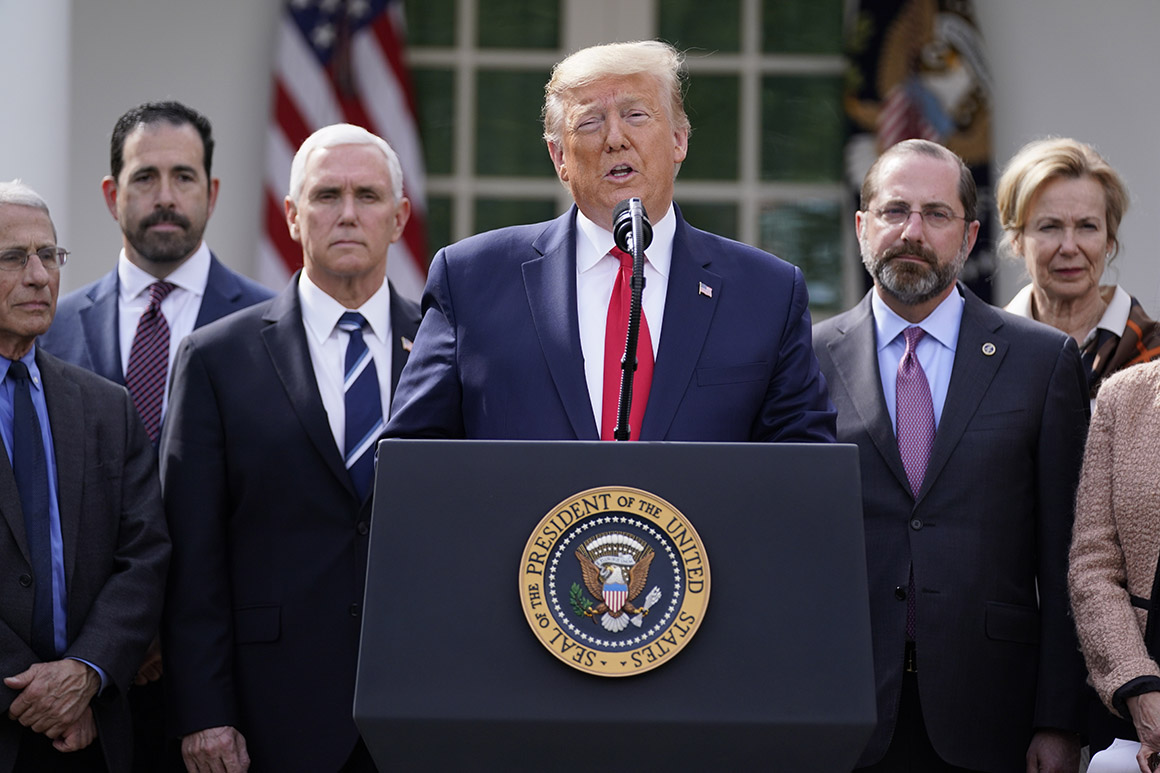
In addition to his executive actions, Trump has pressed Congress for an economic stimulus package that could amount to hundreds of billions of dollars. Late Friday, Pelosi announced that she had clinched a deal with Treasury Secretary Steven Mnuchin on a package meant to provide paid leave for workers, expand food aid and support widespread testing for the illness at no cost to patients.
Only hours earlier, Trump had said during his press conference that he did not yet support the latest version of the bill.
“We just don’t think they’re giving enough,” he said. “We don’t think the Democrats are giving enough.”
Friday’s national emergency declaration was considerably different than one the White House earlier this week had signaled was being prepared. A White House aide involved in the coronavirus response told POLITICO on Wednesday that Trump would sign a limited emergency declaration that only addressed the faltering economy by unleashing billions of dollars for loans to small businesses and to cover missed paychecks for hourly workers.
But Democrats and many health care industry leaders were pressuring Trump to declare a more expansive emergency to help hard-hit states build mobile hospitals and shelters, while assisting with public safety and other issues.
White House documents referenced both the Stafford Act, which is designed to activate the Federal Emergency Management Agency, and the National Emergencies Act, the same law he invoked last year to repurpose government funds for construction of a southern border.
But the president only said his order would increase the powers of the Department of Health and Human Services, the lead agency thus far in the administration’s coronavirus response. Under Friday’s order, HHS will be able to waive certain Medicare, Medicaid or Children’s Health Insurance Program requirements in an effort to bypass time-consuming regulations.
Separately, Trump said the federal government will waive interest on federal student loans and would purchase additional crude oil for the nation’s reserves.
“This will pass,” he said. “This will pass through. We’re going to be even stronger for it. We learned a lot, a tremendous amount has been learned.”
Previously, Trump had been reluctant to declare a more sweeping national emergency, fearful of stoking panic with such a dramatic step. But his thinking evolved as the American coronavirus caseload soared past 1,600 this week, with public health officials warning the country to expect a spike in the coming days.
For weeks, Trump has tried to reassure Americans that the widening outbreak is under control. But the situation has escalated in recent days.
The stock market has dropped in record numbers not seen since the 2008 recession, and much of the country — from Disney World to professional sports leagues, museums and concert halls — has shut down. Across the U.S., the coronavirus has now killed more than 40 people and health officials have warned that the situation will worsen.
Trump made another attempt to calm Wall Street during a brief prime-time Oval Office address on Wednesday. But he instead caused more confusion when he misrepresented the contours of a 30-day ban on foreign visitors from Europe and misstated that insurance companies had promised to fully pay for people’s coronavirus treatment.
Friday’s declaration builds on a previous, agency-specific „public health emergency“ declaration HHS made in January. The move unlocked some initial federal money and resources. But Friday’s two designations are much broader.
Still, some disaster management experts were disappointed that Trump on Friday did not appear to task FEMA — the agency that oversees hurricane, tornado and flood response — with leading the government’s coronavirus response plan.
“FEMA has an important role in coordinating the larger response to the crisis,” said Tim Manning, a former FEMA deputy administrator. “If there’s an emergency, FEMA needs to be involved. I’m not sure how it could be done mechanically or legally without FEMA.”
FEMA has previously helped with government responses to other insidious dangerous outbreaks, including SARS, MERS and Ebola.
While previous presidents have made emergency declarations “virus threat” disasters — Bill Clinton did it for West Nile virus under the Stafford Act — it is rare, former FEMA officials say.
Source: politico.com
See more here: news365.stream






